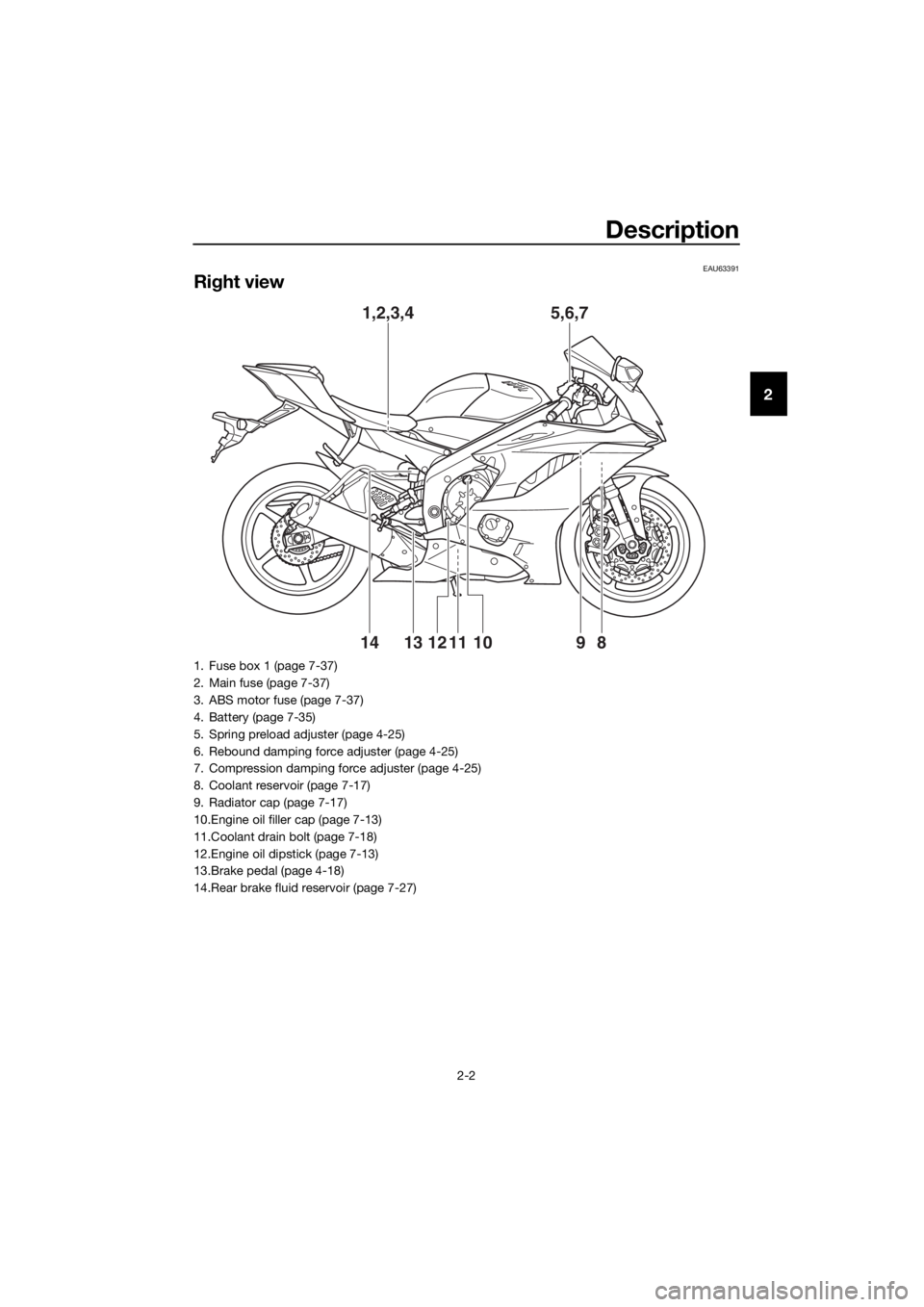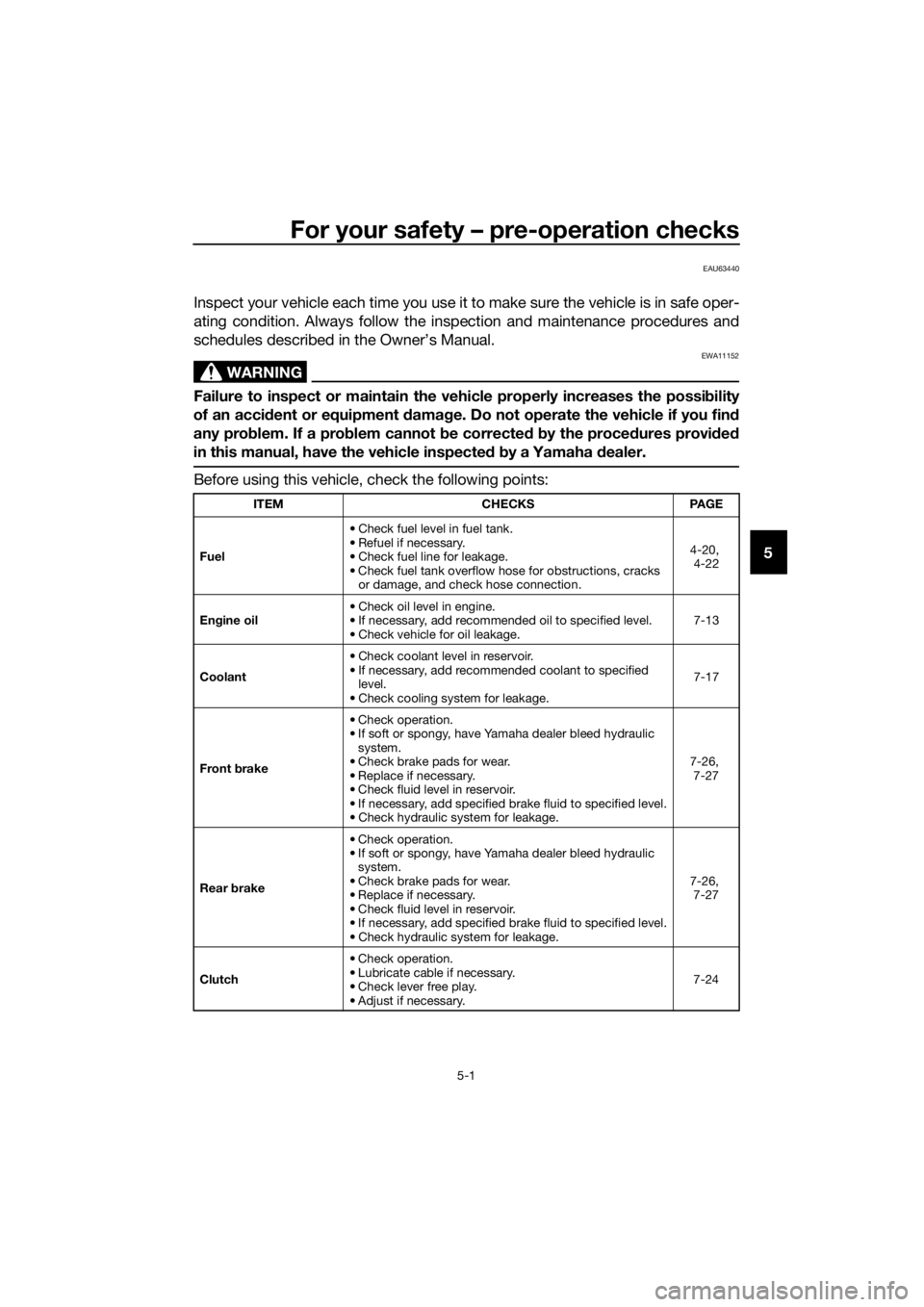brake YAMAHA YZF-R6 2017 Owners Manual
[x] Cancel search | Manufacturer: YAMAHA, Model Year: 2017, Model line: YZF-R6, Model: YAMAHA YZF-R6 2017Pages: 114, PDF Size: 4.2 MB
Page 5 of 114

Table of contents
Safety information ............................1-1
Description ........................................2-1
Left view ..........................................2-1
Right view........................................2-2
Controls and instruments ................2-3
Special features ................................3-1
D-mode (drive mode) ......................3-1
Traction control system...................3-2
Quick shift system ...........................3-4
Instrument an d control functions ....4-1
Immobilizer system .........................4-1
Main switch/steering lock ...............4-2
Handlebar switches.........................4-4
Indicator lights and warning
lights ............................................4-5
Multi-function meter unit .................4-8
Clutch lever ...................................4-17
Shift pedal .....................................4-17
Brake lever ....................................4-18
Brake pedal ...................................4-18
ABS ...............................................4-19
Fuel tank cap.................................4-20
Fuel................................................4-20
Fuel tank overflow hose ................4-22
Catalytic converters .....................4-22
Seats .............................................4-23
Rear view mirrors ..........................4-24
Adjusting the front fork..................4-25
Adjusting the shock absorber assembly....................................4-27
EXUP system ................................4-29
Auxiliary DC connector .................4-30
Sidestand ......................................4-30
Ignition circuit cut-off system........4-31
For your safety – pre-operation
checks ...............................................5-1
Operation an d important ri din g
points .................................................6-1
Starting the engine ..........................6-2
Shifting ............................................6-3 Tips for reducing fuel
consumption................................ 6-4
Engine break-in ............................... 6-4
Parking ............................................ 6-5
Perio dic maintenance an d
a d justment ........................................ 7-1
Owner’s tool kit ............................... 7-2
Periodic maintenance chart for the
emission control system.............. 7-3
General maintenance and
lubrication chart........................... 7-4
Removing and installing cowlings and panels ................................... 7-7
Checking the spark plugs ............. 7-11
Canister......................................... 7-12
Engine oil and oil filter cartridge ... 7-13
Coolant ......................................... 7-17
Air filter element ............................ 7-19
Checking the engine idling speed......................................... 7-20
Checking the throttle grip free play ............................................ 7-20
Valve clearance ............................. 7-21
Tires .............................................. 7-21
Cast wheels .................................. 7-24
Adjusting the clutch lever free play ............................................ 7-24
Checking the brake lever free
play ............................................ 7-25
Brake light switches ...................... 7-26
Checking the front and rear brake pads................................. 7-26
Checking the brake fluid level....... 7-27
Changing the brake fluid............... 7-28
Drive chain slack ........................... 7-29
Cleaning and lubricating the drive chain ................................. 7-30
Checking and lubricating the cables ........................................ 7-31
Checking and lubricating the
throttle grip and cable ............... 7-31
Checking and lubricating the brake and shift pedals ............... 7-32
Checking and lubricating the
brake and clutch levers ............. 7-32
UBN6E0E0.book Page 1 Wednesday, January 25, 2017 1:28 PM
Page 13 of 114

Description
2-2
2
EAU63391
Right view
1,2,3,45,6,7
9
8
11121314 10
1. Fuse box 1 (page 7-37)
2. Main fuse (page 7-37)
3. ABS motor fuse (page 7-37)
4. Battery (page 7-35)
5. Spring preload adjuster (page 4-25)
6. Rebound damping force adjuster (page 4-25)
7. Compression damping force adjuster (page 4-25)
8. Coolant reservoir (page 7-17)
9. Radiator cap (page 7-17)
10.Engine oil filler cap (page 7-13)
11.Coolant drain bolt (page 7-18)
12.Engine oil dipstick (page 7-13)
13.Brake pedal (page 4-18)
14.Rear brake fluid reservoir (page 7-27)
UBN6E0E0.book Page 2 Wednesday, January 25, 2017 1:28 PM
Page 14 of 114

Description
2-3
2
EAU63401
Controls and instruments
12 4 35678
1. Clutch lever (page 4-17)
2. Left handlebar switches (page 4-4)
3. Main switch/steering lock (page 4-2)
4. Multi-function meter unit (page 4-8)
5. Front brake fluid reservoir (page 7-27)
6. Right handlebar switches (page 4-4)
7. Brake lever (page 4-18)
8. Throttle grip (page 7-20)
UBN6E0E0.book Page 3 Wednesday, January 25, 2017 1:28 PM
Page 25 of 114

Instrument and control functions
4-7
4
The electrical circuit of the warning
light can be checked by turning the key
to “ON”. The warning light should
come on for a few seconds, and then
go off.
If the warning light does not come on
initially when the key is turned to “ON”,
or if the warning light remains on, have
a Yamaha dealer check the vehicle.
EAU69891ABS warnin
g li ght “ ”
In normal operation, this warning light
comes on when the key is turned to
“ON”, and goes off after traveling at a
speed of 10 km/h (6 mi/h) or higher.
If the ABS warning light: does not come on when the key is
turned to “ON”
comes on or flashes while riding
does not go off after traveling at a
speed of 10 km/h (6 mi/h) or high-
er
The ABS may not work correctly. If any
of the above occurs, have a Yamaha
dealer check the system as soon as
possible. (See page 4-19 for an expla-
nation of the ABS.)
WARNING
EWA16041
If the ABS warnin g li ght does not go
off after travelin g at a speed of 10
km/h (6 mi/h) or hi gher, or if the
warnin g li ght comes on or flashes
while ri din g, the b rake system re-
verts to conventional brakin g. If ei-
ther of the ab ove occurs, or if the
warnin g li ght does not come on at
all, use extra caution to avoid possi-
b le wheel lock durin g emer gency b
rakin g. Have a Yamaha d ealer
check the brake system an d electri-
cal circuits as soon as possi ble.
EAU77002Traction control system in dicator
li g ht “ ”
This indicator light flashes when trac-
tion control has engaged. If the traction
control system is turned off, the indica-
tor light will come on.
When the vehicle is turned on, the light
will perform a circuit check (come on
for a few seconds and then go off). If
the light does not come on during the
circuit check, or if the light remains on,
Yamaha dealer check the vehicle.
EAU80370Shift li ght
This light can be set to come on and go
off at select engine speeds. (See page
4-15.)
When the vehicle is turned on, the light
will perform a circuit check (come on
for a few seconds and then go off).
If the light does not come on during the
circuit check, have a Yamaha dealer
check the vehicle.
EAU80300Immo bilizer system in dicator li ght
When the key is turned to “OFF” and
30 seconds have passed, the indicator
light will flash steadily to indicate the
immobilizer system is enabled. After 24
hours have passed, the indicator light
will stop flashing, however the immobi-
lizer system is still enabled.
The electrical circuit of the indicator
light can be checked by turning the key
to “ON”. The indicator light should
come on for a few seconds, and then
go off.
ABS
UBN6E0E0.book Page 7 Wednesday, January 25, 2017 1:28 PM
Page 36 of 114

Instrument and control functions
4-18
4
EAU26825
Brake lever
The brake lever is located on the right
side of the handlebar. To apply the
front brake, pull the lever toward the
throttle grip.
The brake lever is equipped with a
brake lever position adjusting dial. To
adjust the distance between the brake
lever and the throttle grip, turn the ad-
justing dial while holding the lever
pushed away from the throttle grip.
Make sure that the appropriate setting
on the adjusting dial is aligned with
the “ ” mark on the brake lever.
EAU12944
Brake ped al
The brake pedal is located on the right
side of the motorcycle. To apply the
rear brake, press down on the brake
pedal.
1. Brake lever
2. Distance between brake lever and throttle
grip
3. “ ” mark
4. Brake lever position adjusting dial
1
43 2
1. Brake pedal
1
UBN6E0E0.book Page 18 Wednesday, January 25, 2017 1:28 PM
Page 37 of 114

Instrument and control functions
4-19
4
EAU63040
ABS
The Yamaha ABS (Anti-lock Brake
System) features a dual electronic con-
trol system, which acts on the front and
rear brakes independently.
Operate the brakes with ABS as you
would conventional brakes. If the ABS
is activated, a pulsating sensation may
be felt at the brake lever or brake ped-
al. In this situation, continue to apply
the brakes and let the ABS work; do
not “pump” the brakes as this will re-
duce braking effectiveness.
WARNING
EWA16051
Always keep a sufficient d istance
from the vehicle ahead to match the
ri din g speed even with ABS.
The ABS performs b est with
lon g b rakin g d istances.
On certain surfaces, such as
rou gh or g ravel roa ds, the b rak-
in g d istance may be lon ger with
the ABS than without.
The ABS is monitored by an ECU,
which will revert the system to conven-
tional braking if a malfunction occurs.
TIP
The ABS performs a self-diagno-
sis test each time the vehicle first
starts off after the key is turned to
“ON” and the vehicle has traveled
at a speed of 10 km/h (6 mi/h) or
higher. During this test, a “click-
ing” noise can be heard from the
hydraulic control unit, and if the
brake lever or brake pedal is even
slightly applied, a vibration can be
felt at the lever and pedal, but
these do not indicate a malfunc-
tion.
This ABS has a test mode which
allows the owner to experience
the pulsation at the brake lever or
brake pedal when the ABS is op-
erating. However, special tools are
required, so please consult your
Yamaha dealer.
NOTICE
ECA20100
Be careful not to d amage the wheel
sensor or wheel sensor rotor; other-
wise, improper performance of the
ABS will result.
1. Front wheel sensor rotor
2. Front wheel sensor
1. Rear wheel sensor
2. Rear wheel sensor rotor
1
2
1
2
UBN6E0E0.book Page 19 Wednesday, January 25, 2017 1:28 PM
Page 51 of 114

For your safety – pre-operation checks
5-1
5
EAU63440
Inspect your vehicle each time you use it to make sure the vehicle is in safe oper-
ating condition. Always follow the inspection and maintenance procedures and
schedules described in the Owner’s Manual.
WARNING
EWA11152
Failure to inspect or maintain the vehicle properly increases the possibility
of an acci dent or equipment d amage. Do not operate the vehicle if you fin d
any prob lem. If a pro blem cannot be corrected b y the proce dures provi ded
in this manual, have the vehicle inspecte d b y a Yamaha d ealer.
Before using this vehicle, check the following points:
ITEM CHECKSPAGE
Fuel • Check fuel level in fuel tank.
• Refuel if necessary.
• Check fuel line for leakage.
• Check fuel tank overflow hose for obstructions, cracks
or damage, and check hose connection. 4-20,
4-22
En gine oil • Check oil level in engine.
• If necessary, add recommended oil to specified level.
• Check vehicle for oil leakage. 7-13
Coolant • Check coolant level in reservoir.
• If necessary, add recommended coolant to specified
level.
• Check cooling system for leakage. 7-17
Front brake • Check operation.
• If soft or spongy, have Yamaha dealer bleed hydraulic
system.
• Check brake pads for wear.
• Replace if necessary.
• Check fluid level in reservoir.
• If necessary, add specified brake fluid to specified level.
• Check hydraulic system for leakage. 7-26,
7-27
Rear brake • Check operation.
• If soft or spongy, have Yamaha dealer bleed hydraulic
system.
• Check brake pads for wear.
• Replace if necessary.
• Check fluid level in reservoir.
• If necessary, add specified brake fluid to specified level.
• Check hydraulic system for leakage. 7-26,
7-27
Clutch • Check operation.
• Lubricate cable if necessary.
• Check lever free play.
• Adjust if necessary. 7-24
UBN6E0E0.book Page 1 Wednesday, January 25, 2017 1:28 PM
Page 52 of 114

For your safety – pre-operation checks
5-2
5
Throttle grip • Make sure that operation is smooth.
• Check throttle grip free play.
• If necessary, have Yamaha dealer adjust throttle grip
free play and lubricate cable and grip housing. 7-20,
7-31
Control ca bles • Make sure that operation is smooth.
• Lubricate if necessary.
7-31
Drive chain • Check chain slack.
• Adjust if necessary.
• Check chain condition.
• Lubricate if necessary. 7-29,
7-30
Wheels an d tires •Check for damage.
• Check tire condition and tread depth.
• Check air pressure.
• Correct if necessary. 7-21,
7-24
Brake an d shift pe dals • Make sure that operation is smooth.
• Lubricate pedal pivoting points if necessary. 7-32
Brake an d clutch le-
vers • Make sure that operation is smooth.
• Lubricate lever pivoting points if necessary.
7-32
Si destan d • Make sure that operation is smooth.
• Lubricate pivot if necessary. 7-33
Chassis fasteners • Make sure that all nuts, bolts and screws are properly
tightened.
• Tighten if necessary. —
Instruments, li ghts,
si gnals an d switches • Check operation.
• Correct if necessary.
—
Si destan d switch • Check operation of ignition circuit cut-off system.
• If system is not working correctly, have Yamaha dealer
check vehicle. 4-30
ITEM
CHECKSPAGE
UBN6E0E0.book Page 2 Wednesday, January 25, 2017 1:28 PM
Page 58 of 114

Periodic maintenance an d a djustment
7-1
7
EAU17246
Periodic inspection, adjustment, and
lubrication will keep your vehicle in the
safest and most efficient condition
possible. Safety is an obligation of the
vehicle owner/operator. The most im-
portant points of vehicle inspection,
adjustment, and lubrication are ex-
plained on the following pages.
The intervals given in the periodic
maintenance charts should be simply
considered as a general guide under
normal riding conditions. However, de-
pending on the weather, terrain, geo-
graphical location, and individual use,
the maintenance intervals may need to
be shortened.
WARNING
EWA10322
Failure to properly maintain the vehi-
cle or performin g maintenance ac-
tivities incorrectly may increase
your risk of injury or d eath durin g
service or while usin g the vehicle. If
you are not familiar with vehicle ser-
vice, have a Yamaha d ealer perform
service.
WARNING
EWA15123
Turn off the en gine when performin g
maintenance unless otherwise
specified .
A runnin g en gine has movin g
parts that can catch on body
parts or clothin g an d electrical
parts that can cause shocks or
fires.
Runnin g the en gine while ser-
vicing can lead to eye injury,
b urns, fire, or car bon monoxi de
poisonin g – possi bly lea din g to d
eath. See pag e 1-3 for more in-
formation a bout car bon monox-
i d e.
WARNING
EWA15461
Brake discs, calipers, drums, an d
linin gs can b ecome very hot during
use. To avoi d possi ble burns, let
b rake components cool before
touchin g them.
UBN6E0E0.book Page 1 Wednesday, January 25, 2017 1:28 PM
Page 61 of 114

Periodic maintenance an d a djustment
7-4
7
EAU71372
General maintenance an d lu brication chart
NO. ITEM
1 *Dia
gnostic system
check • Perform dynamic inspection
using Yamaha diagnostic tool.
• Check the error codes. √√√√√√
2 *Air filter element • Replace. Every 40000 km (24000 mi)
3Clutch • Check operation.
•Adjust. √√√√√
4 *Front brake • Check operation, fluid level,
and for fluid leakage.
• Replace brake pads if neces- sary. √√√√√√
5 *Rear brake • Check operation, fluid level,
and for fluid leakage.
• Replace brake pads if neces- sary. √√√√√√
6 *Brake hoses • Check for cracks or damage.
√√√√√
• Replace. Every 4 years
7 *Brake flui d • Change. Every 2 years
8 *Wheels • Check runout and for damage.
• Replace if necessary. √√√√
9 *Tires • Check tread depth and for
damage.
• Replace if necessary.
• Check air pressure.
• Correct if necessary. √√√√√
10 *Wheel bearin gs • Check bearing for looseness or
damage. √√√√
11 *Swin
garm pivot
b earin gs • Check operation and for exces-
sive play. √√√√
• Lubricate with lithium-soap- based grease. Every 50000 km (30000 mi)
12 Drive chain • Check chain slack, alignment
and condition.
• Adjust and lubricate chain with a special O-ring chain lubricant
thoroughly. Every 800 km (500 mi) and after
washing the motorcycle, riding
in the rain or riding in wet areasX 1000 km
CHECK OR
MAINTENANCE JOB
X 1000 mi
ODOMETER READINGS
ANNUAL CHECK
110203040
0.66121824
UBN6E0E0.book Page 4 Wednesday, January 25, 2017 1:28 PM